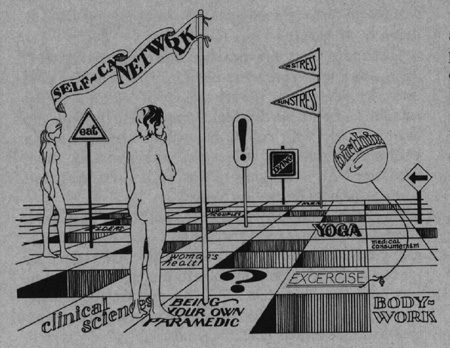First of all, we don't mean to imply that everybody should have a self-care plan. If things are going well for you, if you are satisfied with the present pattern of your life and not particularly interested in making changes at the moment, good for you. Keep it up. These guidelines are for those who are already interested in making some gentle changes.
Second, remember that the advice that follows has proved useful for some people. They are ideas to try, not commandments.
Third, the goal-setting exercise that accompanies this article is just that--an exercise. It gives you an opportunity to define and state a commitment you would like to make to yourself. This is a commitment to yourself, not an irrevocable promise sealed in blood and cast in concrete. Think of it as an opportunity to "try on" some new behavior patterns. You are free to go back and revise your goals at any time.
You may want to make photocopies of the exercise so that you can be able to see it more than once.

Guideline One: Pick a Goal That Turns You On
Build on strengths. Cultivate excitement. Starve problems and feed solutions. If you are a smoker and the idea of a regular running program appeals to you, you might find yourself quitting cigarettes about the time you get up to three or four miles a day. If you have a problem with weight control, and you've always been intrigued by meditation, a daily meditation session might be more useful than a whole stack of diet books. Goals that enrich your life are usually more successful--and are certainly a lot more fun--than goals that deprive you of something.
Guideline Two: Start by Just Paying Attention
An excellent way to start an exercise program is to buy a pedometer--a small, watch-sized instrument that hangs from your belt and records the number of steps you take (available from running, sporting goods, and backpacking stores and chart the total miles you walk each day. A good way to start an eating program is to write down everything you eat for a period of time. To start a smoking program, write down where and when and why you smoke each cigarette. Pay close attention to the ways that other people support desired or undesired behavior in the area you have chosen. Do family members insist on offering you high-calorie goodies? Does everyone else at work light up right after lunch? Don't try to change anything yet, just pay attention.
Guideline Three: Check Out Your Available Resources
Start with your own personal resources. Were you an athlete in high school? If so, maybe you can reconnect with some of the habits and practices that kept you in shape back then. Do you love to cook? Maybe you would enjoy developing some nutritious natural-food recipes. Is there a musical instrument or an art or craft that once meant a lot to you? Reconnecting with these areas of interest might be a way to further your own process of self-integration. Have you always had a dream of being a dancer? A painter? A writer? This may be an opportunity to develop these interests.
What individuals and groups in your community would be the best resources in your chosen area? Who already knows about what you want to know'? Are there support groups in your chosen area (Weight Watchers, Alcoholics Anonymous, women's consciousness raising groups? Do you have friends who have lost weight, who are runners, meditators, or whatever? What are the best publications in the area you have chosen?